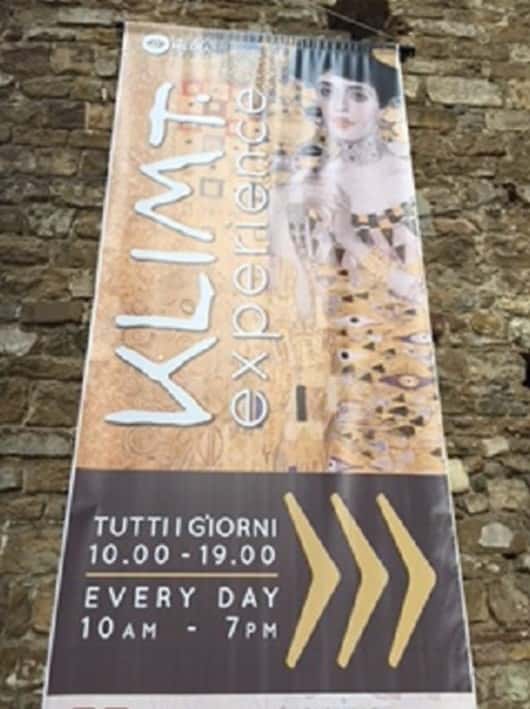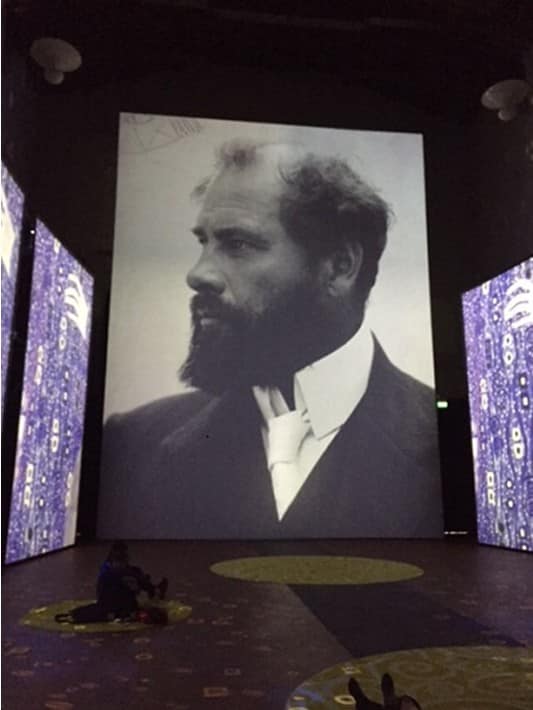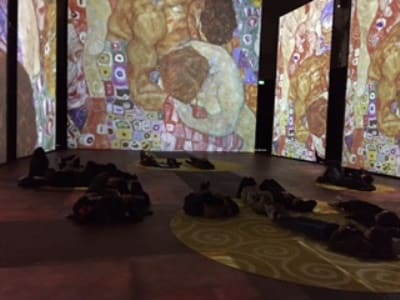When I heard that they were having a Klimt exhibit at the Santo Stefano al Ponte church in Florence, I headed over right away to take a look.
Gustav Klimt (1862–1918) was an Austrian painter active during the late 19th and early 20th century. His most famous works include The Kiss, Portrait of Adele Bloch-Bauer, and Death and Life. Klimt’s immediately recognizable style, which features distinctive Art Nouveau elements, is so memorable that it seems there is hardly anyone who does not know of his work.In my mind, Klimt became such a blockbuster artist less because of what he painted and more because of how he painted it—particularly his use of gold leaf, geometric forms, rectangular shapes, and so on. I’m sure that when you look at a Klimt painting, your eyes are also drawn more to the decorative elements than the human forms, right? Of course, you are also sure to experience both the threatening and fragile nature of the sensual female form.Klimt was constantly painting portraits of women from wealthy families and the business world, but he is also famous for his raw, sensual depictions of sex, pregnancy, and the nude form. While his works primarily offer a sweet, voluptuous eroticism, they also contain elements of fragility and the menacing specter of death.
Even Klimt’s famous work The Kiss provides an example of these elements. The man is offering an awkward kiss as an ecstatic expression rises to the woman’s face. And yet, her feet dangle off the bed of flowers below as she threatens to plunge from the edge of the cliff any moment. We are left with a scene that is not simply beautiful, but fleeting as well.
Klimt did have one woman to whom he was lovingly devoted all his life, but his relationships with women were said to be intense, with as many as fifteen companions coming and going at any one time. Although he fathered numerous children with his lovers, he never married before dying fairly young at 55 years old.Klimt was balding before age 50, and when I first saw his photograph, I couldn’t believe that this was the erotic, virile painter who gave the world so many beautiful, ephemeral works. The mismatch was so powerful that it left me doubting my own eyes.As I looked over the various images in the exhibit, however, I began to see that mismatch itself as something wonderful, and felt that I understood the powerful attraction of Klimt that caused so many women to be drawn to him. I even thought that I myself might have fallen for him had I been born during that time. After all, the fact that his works are so loved and popular all over the world is surely testament to his abilities.Seeing the recent exhibit was like going to an innovative museum with a completely fresh, modern style, and the first thing that surprised me was that the admission charge was significantly higher than at the Uffizi Gallery—despite the fact that not a single original Klimt piece was on display. The first thing you saw when you walked in was the enormous photograph of the artist himself. Behind it was an area where visitors sat in chairs and put on 3D glasses that gave them access to Klimt’s world. The experience was so powerful, with so many gorgeous images, that I lost all sense of where I was. Next, visitors descended stairs into a small hall that looked like it was set up to enjoy images and music, but if there were those who sat and looked as if they were watching a movie, there were also those who were laying on the floor of the church as they viewed the images. It’s hard to describe in words, but suffice it to say that I had never experienced an exhibit that immersed you so fully in the artwork.I came away unexpectedly moved and completely refreshed from the stress of everyday life. It was truly amazing!
The Klimt exhibition goes through April 2, so if any of you have plans to be in Florence before then, I highly recommend that you immerse yourselves in the world of Klimt at this fresh and innovative event.


































































